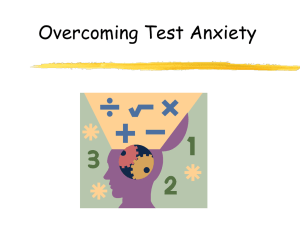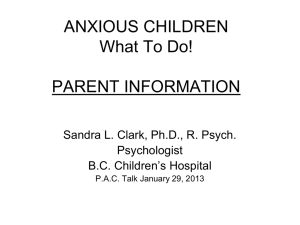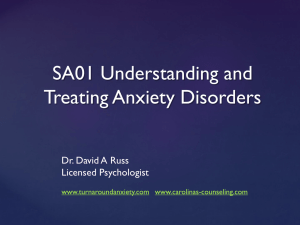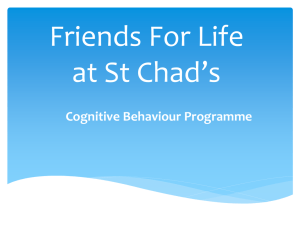CopinG_Cat_Smith, 860.50 KB, 2/10/2012
advertisement
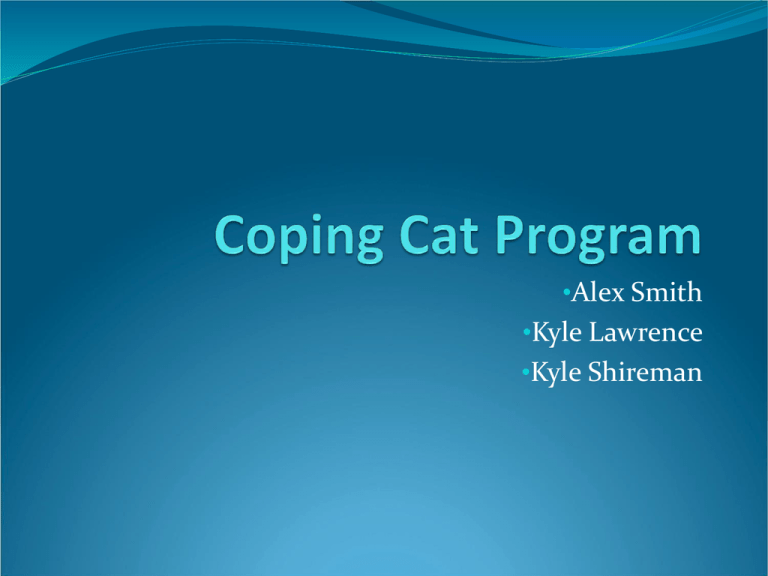
•Alex Smith •Kyle Lawrence •Kyle Shireman Introduction CBT tool for youth anxiety (7 – 13 years old) who meet criteria for Generalized Anxiety Disorder, Social Phobia, and/or Separation Anxiety Disorder. Consists of 16 sessions, follows a therapist manual, uses a client workbook. Manual guides treatment, workbook contains client tasks. Intro (con’t) Sessions 1-8: Dedicated to psychoeducation. The client learns to identify cues for anxiety and skills to help him/her cope with anxiety. Sessions 9-16: Behavior focused. The client faces his/her fears in a graded hierarchy. FEAR Plan “F” : Feeling Frightened? Focuses on somatic reactions to anxiety “E” : Expecting Bad Things to happen? Helps youth identify anxious cognitions “A” : Attitudes and Actions that Can Help. Provides coping skills for the youth implement (coping thoughts, problemsolving, relaxation, belly breathing) “R” : Results and Rewards. Allows youth to rate their performance and effort and be rewarded for facing their fears. Beidas, Rinad S., Benjamin, Courtney L., Puleo, Connor M., Edmunds, Julie M., Kendall, Philip C. (2010). Flexible applications of the Coping Cat Program for anxious youth. Cognitive and Behavioral Practice, 17, 142-153. Evidence-base of Coping Cat 47 children were referred (ages 9-13) due to principal diagnosis of anxiety. Compared to control, participants demonstrated a significant positive change from pre- to posttreatment on self-report, parent report, and behavioral observations (Kendall, 1994). 36 of the previous 47 children were reassessed and treatment strategies/gains were maintained at a 3.35 year follow-up (Kendall & Southam-Gerow, 1996). Coping Cat has been effectively modified in other countries and results indicate that 50% to 72% of participants no longer meet criteria for their preexisting anxiety disorder (Barret, Dadds, & Rappee 1996). Sources: Barrett, P.M., Dadds, M.M., & Rappee, R.M. (1996). Family treatment of childhood anxiety: a controlled trial. Journal of Consulting and Clinical Psychology, 64, 333-342. Kendall, P.C. (1994). Treating anxiety disorders in children: Results of a randomized clinical trial. Journal of Consulting and Clinical Psychology, 62, 100-110. Kendall, P.C. & Southam-Gerow, M. (1996). Long-term follow-up of a cognitive behavioral therapy for anxietydisordered youths . Journal of Consulting and Clinical Psychology, 64, 724.730. When would you use Coping Cat? Help youth cope with anxiety Age Range for Coping Cat Program is 7-13 yrs old for children who meet criteria for Generalized Anxiety Disorder, Social Phobia, and/or Separation Anxiety Disorder. Program for Adolescents- Cognitive Analytic Therapy (C.A.T) project-ages 13-17. Appropriate Populations: No differences in outcomes based on ethnicity or gender Understanding a child’s developmental level (child should have an IQ of over 80 to understand) Beidas, Rinad S., Benjamin, Courtney L., Puleo, Connor M., Edmunds, Julie M., Kendall, Philip C. (2010). Flexible applications of the Coping Cat Program for anxious youth. Cognitive and Behavioral Practice, 17, 142-153. Potential Barriers/Strategies to Overcome Barriers Barrier: Younger children (7-8 yrs old) – They may not understand the feelings that you are trying to explain so using play to help discover feelings, thoughts, and behaviors. Strategy to Overcome: Games: Charades- Act out the feelings. Feelings Dictionary. Spy Detective: Go around looking for different feelings. Drawing the feelings Barrier: Kids with Social Skills Deficit Strategy to Overcome: Discuss basic emotions, (Sad, afraid, happy). Challenge children to work on the “E step” thoughts and the “A step” actions. These children worry about fitting in which can be legitimate. Counselor should work on separating their realistic and unrealistic thoughts and then work on their actions (Exposure Task). Beidas, Rinad S., Benjamin, Courtney L., Puleo, Connor M., Edmunds, Julie M., Kendall, Philip C. (2010). Flexible applications of the Coping Cat Program for anxious youth. Cognitive and Behavioral Practice, 17, 142-153. Potential Barriers/Strategies to Overcome Barriers Barrier: Inattentive/Hyperactive Kids Strategy to Overcome: High Structure with shorter intervals interspersed with short breaks. (breaks can include jumping jacks or a short game). Use a picture schedule with the breaks built in so that the child can see when they will get breaks. Increase interactions and engagements (use charades for the feelings part instead of collage or having a catch with a nerf ball while discussing feelings). Alter the setting so that there are minimal visual distractions. Work in a reward system. 32% comorbidity with Anxiety. Beidas, Rinad S., Benjamin, Courtney L., Puleo, Connor M., Edmunds, Julie M., Kendall, Philip C. (2010). Flexible applications of the Coping Cat Program for anxious youth. Cognitive and Behavioral Practice, 17, 142-153. Potential Barriers/Strategies to Overcome Barriers Barrier: Depressive Symptoms Strategies to Overcome: A child who is comorbid with anxiety and depression may not improve with just anxiety interventions. Increase the rapport building time to longer than just one session. Possibly spend the first 10 minutes of each session building rapport. Cognitive restructuring : When going over the automatic thoughts be on the lookout for negative cognitions and spend time on those thoughts. Attempt to increase their activity levels (Exposure therapy). Beidas, Rinad S., Benjamin, Courtney L., Puleo, Connor M., Edmunds, Julie M., Kendall, Philip C. (2010). Flexible applications of the Coping Cat Program for anxious youth. Cognitive and Behavioral Practice, 17, 142-153. Process of Using Intervention Session 1: Build Rapport, provide overview of program. Encourage child’s participation. Play personal facts game…promote fun activities Session 5: Introduce relaxation training. (e.g. deep breathing and progressive relaxation). Review recognition of somatic cues. Session 2: Talk about treatment goals. Identify different feelings and somatic responses to anxiety. Normalize fear/anxiety. Develop a hierarchy of anxiety-provoking situations. Introduce “F” step of the FEAR plan…remember??? Sessions 6: Review relaxation training. Introduce “E” step of FEAR plan. Help child recognize anxious thoughts. Promote positive self-talk via modeling and cartoons. Session 7: Review anxious self-talk and reinforce changing anxious self talk into coping self talk. Introduce problem solving and the “A” step of the FEAR plan- Actions and attitudes that can help. Session 3: Review distinguishing anxious feelings from other feelings. Identify individual somatic responses to anxiety. Session 4: Parent Session. Provide info on treatment and give opportunities to discuss concerns. Encourage ways for parent involvement. Session 8: Introduce self-evaluation and reward… “R” step of FEAR plan- Results and rewards Podell, J.L., Mychailysyn, M., Edmunds, J., Peulo C., & Kendall, P.C. (2010). The Coping Cat program for anxious youth: the FEAR plan comes to life. Cognitive and Behavioral Practice, 17, 132-141. Process of Using Intervention Session 9: Parent session. Explain second half of treatment. This portion may promote greater anxiety. Session 13 : Continue to practice skills for coping in scenarios that promote moderate anxiety. Session 10: Practice 4-step coping (FEAR) plan under low-anxiety situations. Session 14: Practice skills for coping with anxiety in live situations that produce moderate levels of anxiety. Begin planning “commercial” that summarizes experiences to help inform other children Session 11: Continue practicing skills for coping with anxiety in low-level imaginable situations. Session 12: Practice skills for coping in scenarios that promote moderate anxiety. Podell, J.L., Mychailysyn, M., Edmunds, J., Peulo C., & Kendall, P.C. (2010). The Coping Cat program for anxious youth: the FEAR plan comes to life. Cognitive and Behavioral Practice, 17, 132-141. Session 15: Practice skills for coping with anxiety in real situations that produce a high level of anxiety. Session 16: Continue to Practice skills for coping with anxiety in real situations that produce a high level of anxiety. Review and summarize program. Tape “commercial,” award certificate. Demonstration: Session 7: Review anxious self-talk and reinforce changing anxious self talk into coping self talk. Introduce problem solving and the “A” step of the FEAR plan- Actions and attitudes that can help. Conclusion Overall, Coping Cat is a program that utilizes CBT tools to help youths cope with anxiety. The general structure of the program is manualized, but can be adapted to fit individual and group needs. It is flexible! (Beidas et al. 2010; Podell et al. 2010) Therapists can set an agenda, progress monitor, conduct a mood check-in, undergo specific session tasks, provide opportunity for feedback, and conduct mood check-out for each meeting. Children are given any opportunity to practice skills learned through “STIC” tasks between sessions.


